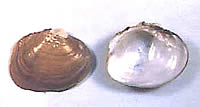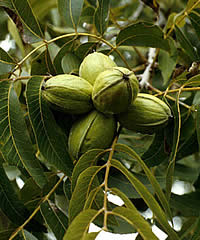“River of Pearls,” “River of Nuts”
El Río de las perlas (river of pearls) and Río de los Nueces (river of nuts), were Spanish names given to what is likely the Concho River at its juncture with the Middle Concho in modern-day Tom Green County. Its rich and varied resources attracted people for thousands of years and captured the attention of travelers during early Historic times. Lined with branching pecan trees and teeming with pearl-producing mussels (freshwater clams, or mollusks), the river was well known to the Spanish by the mid-17th century. Captains Hernan Martin and Diego del Castillo were sent to explore what was then called the “Río de los Nueces” ( Nut River) in 1650. (This river was not the present-day Nueces River on the Edwards Plateau to the south, but more likely the Concho, which means shell).
Their journey resulted in the discovery of the opalescent mussels bearing small colorful “grains,” or pearls, inside them. The two captains and their party stayed in the land among the Jumano Indians for more than a month. Samples of the pink and purple-toned pearls were sent back to Spanish officials in Santa Fe, generating a pulse of excitement for a new industry on the northern frontier. Four years later, Don Diego de la Guadaljara was sent to the area to harvest pearls; some accounts of his journey indicate he was helped by local Indians. The results of this pearl harvesting operation apparently were less than desired, and hopes for an industry gradually died away.
In 1683, Jumano leader Juan Sabeata reported to Gov. Don Antonio de Oertmin at El Paso del Norte that there were many riches in the area where some Jumano nations live; “…on the river called of the nuts there are those shells from which small grains are taken which they call pearls." Several months later Sabeata, again trying to entice the attention of the Spanish, described the area in glowing terms to Governor Domingo Gironza Petriz de Cruzata, saying it had so many nuts that “they are the sustenance of many nations who are friends and trade with his nation.”
The Jumanos and many other nations were hoping to attract Spanish settlements and missions in their lands as a measure to help protect them from the Apache. Their entreaties prompted the Mendoza-Lopez expedition. From February 6-10, 1684, members of the Mendoza-Lopez expedition camped near this location on the banks of a river they called “el rio de las perlas,” or river of pearls.
Credits: This section draws from translations of the Mendoza-Lopez expedition diary by Mariah Wade and locational annotations from her book, The Native American of the Texas Edwards Plateau, 1582-1799 (2002, University of Texas Press) as well as entries in The Handbook of Texas Online.


